Sakura
Cherry-blossom Pilgrim
April.
Skies are blue, and winds are gentle.
It's time for cherry-blossoms.
Many foreign people know that cherry blossom is special for Japanese.
But why is it so? Simply because it is beautiful? Or, does it mean something
more important?
This month, I will introduce you some of the famous historic scenes of cherry blossoms. The piles of these scenes have made up a common feeling towards cherry blossoms in Japanese mind.
Let's pilgrim to the scenes of cherry blossom, crossing the time of thousands
years.
|
To the time of Gods and Goddesses
(Prehistoric time of Mythology)
Konohana-Sakuya-Hime
(Princess Cherry-blossoms)
Amaterasu-Omikami, the Highest Goddess of the Heaven, sent her grandson
Ninigi-no-Mikoto to the Earth to govern it. Ninigi-no-Mikoto one day met
Oyamazumi-no-Kami, the God of Mountains, Sea , Fields and Agriculture.
Ninigi-no-Mikoto married Konohana-Sakuya-Hime, daughter of Oyamazumi-no-Kami.They
had three sons, and one of them became the father of Japan's first Emperor.Jinmu.
This is the origin of Japan.
The word Sakura, came from her name, Sakuya.
In old times, people started to sow the seeds of rice when cherry -blossoms
bloomed.
There are many shrines in all over Japan where the main deity is Konohana-Sakuya-Hime
|
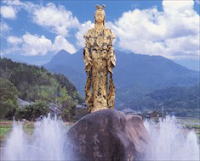
Statue of Konohana-Sakuya-Hime |
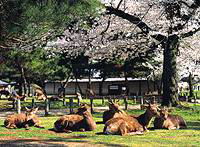
Nara Park |
To the time of Nara Period (710-759AD)
Japan was almost unified by Yamato Dynasty, and the succeeding Nara was
a splendid bloom in culture and wealth. Chinese characters were introduced,
and there sprung up original literature of Japan.
"Manyoshu" is the first anthology of poems.
Here is a famous poem about the beauty of the Capital City. comparing it
to cherry-blossoms in full bloom.
|
éséłéģü@ébéüéÉéēéöéüéīü@éüéöü@éméüéÆéüüC
beautiful in green earth,
flourishes now
like the luster
of the flowers in bloom.
(Translated by Ian Hideo Levy) |
|
To the time of Heian Period (760-1191AD)
Anthologies were edited one after another by the Imperial order. To make
poems was an indispensable education to rise in the court and also to attract
love.
In "Kokin- Wakashu" there came one of the peaks of Waka literature.
One of the highest reputations was Ono no Komachi. She was a fine poet,
but she was also a great court beauty whose love affairs became the plots
of more than one Noh drama. Many of her poems used multiple puns (called
"pivot words") to create complex layers of meaning. In what way
does the poet compare herself to the cherry blossoms in the spring rain?
|
The hue of the cherry
fades too quickly
from sight
all for nothing
this body of mine grows old --
spring rain
ceaselessly falling. |
|
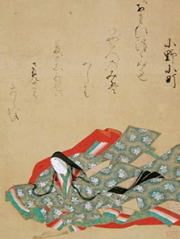
Ono no Komachi |
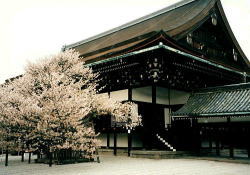
Kyoto Imperial Palace
Shishin-den Building
Sakon-no-sakura( Cherry tree at the Left)
*Left is left seen from the Emperor
|
To the Kyoto Imperial Palace, in the Tale of Genji (early 11th century)
The Book 8 of the Tale of Genji is called "Cherry-blossom Festival".
There, the author Lady Murasaki, described how cherry blossoms were loved
at the court of Heian Period. Emperor, wives and mistresses, court ladies
and noblemen enjoyed the festival., and Genji met another beautiful lady
in this Book8 in the buoyant mood of the spring. It was a hurried, unforgiven
love.
Poem in the story:
|
Could I see the blossom
as other blossoms,
Then would there be no dew
to cloud my heart.
|
|
To Daigo-ji Temple, where Shogun Hideyoshi held the biggest Cherry-blossom Picnic(1593AD)
At the last stage of Hideyoshi's glory, he tried to show his power by planning
an extravagant cherry-blossom festival around Daigo-ji Temple in Kyoto.
At that time, Daigo-ji Temple was a deserted temple, and Hideyoshi constructed
8 main buildings with a huge sum of money. On the day of the festival,
the proud Shogun, with his wives and his son, many Samurais and servants,
1300 people in all, had a picnic through the hill side. About 60 thousand
million yen was used for the constructions and the ladies' kimonos and
for the picnic expenses.
Hideyoshi died only 6 months after that. Hideyoshi's son was ruined by
one of the ministers,Tokugawa Ieyasu, the founder of Tokugawa Bakufu which
continued for 300 years after that until Meiji Restoration
. |
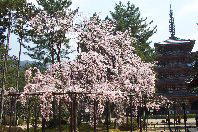
Daigoji Temple |
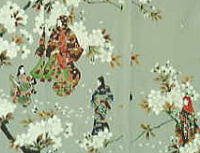
Kimono design of Genroku Cherry Festival |
To Edo Period
Edo was the old name for Tokyo. Tokugawa Ieyasu opened his government (Bakufu)
in Edo. Tokugawa shut the door to the countries of the world except a few
friendly nations. People enjoyed the 300 years of no wars. Wealth was piled
and the culture got ripen. The Genroku period was the time when culture
became too ripened through all the Edo Period. The symbol of the Edo culture
was the cherry-blossom festivals where common people competed the gorgeousness
of the fashion and behavior. It was the time of corruption
|
To the time of World WarćUin the Pacific
(middle of 20th century)
After Meiji Restoration, Japan's National flower cherry blossom gradually changed its character to a symbol that chased soldiers to seek death for the country.
In the Pacific War, cherry blossoms symbolized the young Kamikaze pilots.
They thought they would be reborn as cherry blossoms in Yasukuni Shrine
in Tokyo.
|
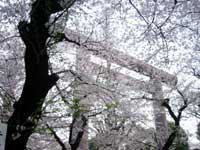
Sakura at Yasukuni Shrine
|
Well, you are back to the cherry-blossoms in 21th century.
I wonder what kind of meaning would be added to the innocent flower in
this still terrible century of wars.
One of my high-school friend, Mrs.Toshiko Ito, living in Tokyo now, has
been planting cherry trees in the war-destructed sites in Sarajebo for
these 5 years. Her noble act reminds me of an old folk story, "Grandfather
Cherry-blossom", who sprinkled ashes to make a dead cherry tree into
a sudden bloom.
I hope you will sprinkle your love to make something live again. |
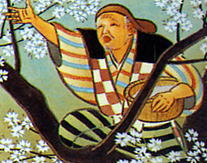 |
| Peace on Earth! |
Thank you, and see you next month.
|